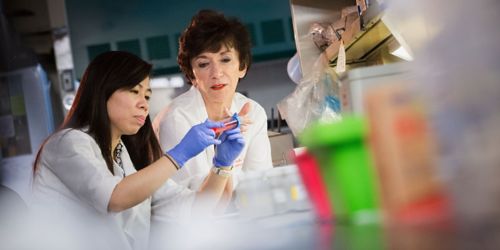St. Jude Family of Websites
Explore our cutting edge research, world-class patient care, career opportunities and more.
St. Jude Children's Research Hospital Home

- Fundraising
St. Jude Family of Websites
Explore our cutting edge research, world-class patient care, career opportunities and more.
St. Jude Children's Research Hospital Home

- Fundraising
A new cancer therapy DAWNs

Martine Roussel, PhD, right, conducts pre-clinical research on medulloblastoma, a type of malignant brain tumor.
How do we figure out what might make a useful cancer therapy? Pre-clinical research refers to studies that take place prior to a clinical trial to help guide the clinical development of new treatments. This type of research can help span the gap between basic discovery and clinical use which can take years.
My laboratory at St. Jude conducts pre-clinical research on a type of malignant pediatric brain tumor called medulloblastoma. The typical treatment regimen includes surgery, radiation and chemotherapy, but this approach is not effective for certain subtypes of the disease and leads to long-term health effects.
To better understand this type of cancer, researchers dug into the genetics underlying these tumors. This work, conducted at St. Jude and elsewhere, classified medulloblastoma into four distinct subtypes: WNT and SHH (which are driven by their namesake genetic mutations), Group 3 and Group 4.
Armed with a more thorough understanding of the genetic differences between the types of medulloblastoma, my laboratory investigated how the molecular factors within these tumor cells interact with and respond to different treatments.
To do this, we needed to create informative laboratory models. Models enable us to study the disease in the context of the genetic mutations that we know underlie various subtypes. Armed with such models, we screened over 4,000 existing drug compounds approved by the Food and Drug Administration to see if any had an effect on medulloblastoma.
We chose to look at existing drugs first because the drug development pipeline flows the smoothest when working with compounds that have already been approved and used for clinical trials in adult cancers. These drugs are more easily translatable into clinical trials for children because they have already undergone rigorous studies, including safety and correct dosing.
Since medulloblastoma is a brain tumor, we needed to test the molecules for the ability to cross the blood-brain barrier – the physical membrane that protects the brain and separates it from the rest of the body. We also tested the compounds’ pharmacokinetics, how the drug is metabolized (processed) by the body. From our initial drug screen, we narrowed down to 832 compounds for a secondary screen. From there, we narrowed the candidates down to 32.
These studies led us to the finding that a class of drugs called CDK4/6 inhibitors might be useful against medulloblastoma. These drugs target enzymes called CDK4 and CDK6 which fuel rapid cell division and growth and are observed to be hyperactive in many cancer cells including medulloblastoma. CDK4/6 inhibitors are already approved for use against other diseases, including breast cancer in combination with estrogen receptor inhibitors. We tested the CDK4/6 inhibitors against a variety of medulloblastoma models and were impressed with the results. Based on our findings, investigators at St. Jude decided to bring CDK4/6 inhibitors into the brain tumor clinic.
SJDAWN – testing novel therapies for patients with brain tumors
St. Jude founder Danny Thomas once said, “No child should die in the dawn of life.” This message has been woven into the fabric of life at St. Jude, embodying the mission that we all share. It also inspired the name of one of the leading-edge clinical trials available only at St. Jude: SJDAWN.
Led by Giles Robinson, MD, SJDAWN is a Phase I clinical trial offering a combination therapy approach for patients at St. Jude with certain types of brain tumors. This clinical trial has three arms, each of which is testing the CDK4/6 inhibitor ribociclib paired with another drug. The three arms are:
- Arm 1: ribociclib and gemcitabine in patients with recurrent Group 3 and Group 4 medulloblastoma and recurrent ependymoma.
- Arm 2: ribociclib and trametinib in patients with recurrent or refractory CNS tumors (but not low-grade glioma and diffuse intrinsic pontine glioma).
- Arm 3: ribociclib and sonidegib in skeletally mature patients up to 39 years old with recurrent SHH medulloblastoma.
This study, which is currently open and enrolling patients, aims to evaluate the safety and tolerability of these combinations. A small expansion cohort to detect preliminary efficacy is also planned.
Creating new cancer therapies requires many steps. Pre-clinical research can provide direction and guidance from the ideas put forward by basic research and discovery. Testing new approaches in the laboratory can also help set clinical trials up for success. While SJDAWN is still ongoing, it stands as an example of the kind of progress that can only be achieved by a team of surgeons, clinicians, computational biologists, statisticians, pharmacokineticians, chemical biologists and molecular biologists in the laboratory working together through all phases of therapeutic development.






